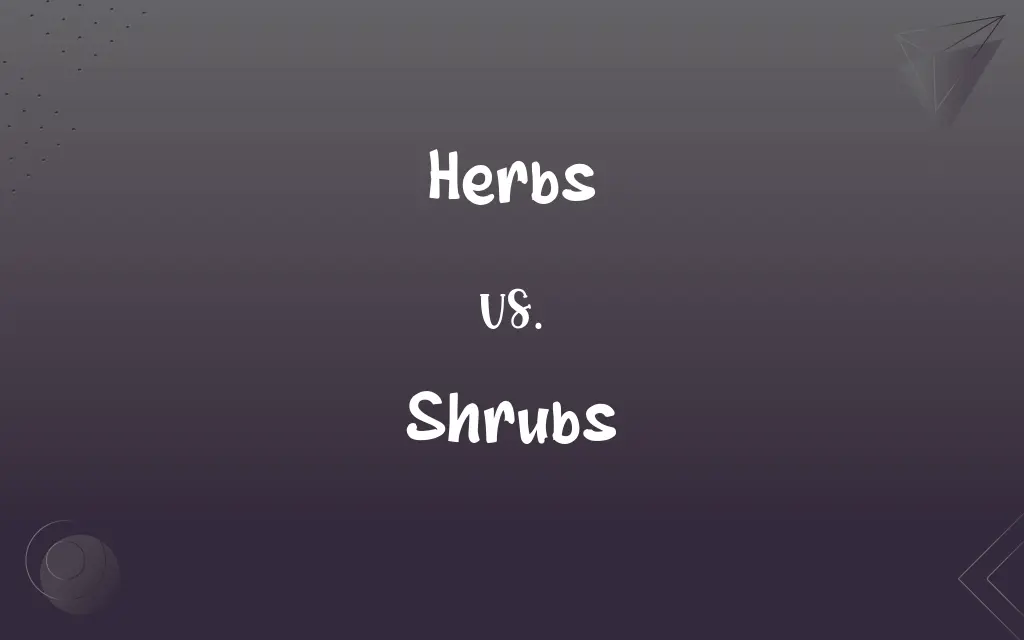Herbs vs. Shrubs: What's the Difference?
Edited by Aimie Carlson || By Harlon Moss || Updated on October 28, 2023
Herbs are typically non-woody plants used for culinary or medicinal purposes, while shrubs are woody, perennial plants with multiple stems.

Key Differences
Herbs and shrubs are terms commonly used to describe specific types of vegetation, but they differ in several ways. Herbs are generally small, non-woody plants that may be used for culinary or medicinal purposes. Many of them are aromatic, and their leaves, stems, or flowers can be used to flavor dishes or brew teas. On the contrary, shrubs are medium-sized, woody plants with multiple stems that arise at or near the ground level. These plants are often used for landscaping or as ornamental features in gardens.
Within the culinary world, herbs are celebrated for their ability to enhance the flavors of various dishes. Popular examples include basil, rosemary, and oregano. Shrubs, however, are not primarily known for culinary uses. Instead, their appeal lies in their decorative qualities and their role in creating structure within gardens or landscapes.
In terms of lifespan and growth, herbs can be either perennial, annual, or biennial. Some herbs, like parsley, live for just a year or two, while others, such as mint, can persist for several years. Shrubs, being woody perennials, typically have a longer lifespan than most herbs and can continue growing for numerous years, sometimes even outliving humans.
Another distinction between herbs and shrubs lies in their practical applications. Apart from culinary and medicinal uses, herbs can also be used in cosmetics, perfumes, and even for religious rituals. Shrubs, meanwhile, serve more as privacy screens, windbreakers, or simply as aesthetic elements in gardens and landscapes.
It's essential to understand these differences to ensure appropriate plant selection, whether for cooking, therapeutic purposes, or landscaping projects. While both herbs and shrubs bring unique characteristics to the table, their distinct nature and uses set them apart in the world of botany and horticulture.
ADVERTISEMENT
Comparison Chart
Definition
Non-woody plants often used for culinary or medicinal purposes
Woody plants with multiple stems rising from the ground
Usage
Culinary, medicinal, cosmetics, perfumes, rituals
Landscaping, ornamental, privacy screens
Life Span
Can be annual, biennial, or perennial
Typically perennial
Texture
Generally non-woody
Woody
Size
Usually smaller
Medium-sized
ADVERTISEMENT
Herbs and Shrubs Definitions
Herbs
Plants with medicinal properties.
Echinacea and ginseng are herbs believed to boost immunity.
Shrubs
Hardier and more robust than herbaceous plants.
Rose shrubs can thrive for years with proper care.
Herbs
Plants used in religious or spiritual rituals.
Sage is an herb commonly used in smudging ceremonies.
Shrubs
Woody plants with multiple stems that arise at or near the ground.
Azaleas are colorful shrubs popular in many gardens.
Herbs
Aromatic plants used in perfumery or cosmetics.
Lavender and chamomile are herbs often found in skincare products.
Shrubs
Medium-sized plants used for ornamental or landscaping purposes.
Boxwood shrubs are often shaped into decorative hedges.
Herbs
Non-woody plants used for flavoring in cooking.
Basil and thyme are popular herbs used in Italian cuisine.
Shrubs
Long-lived, woody plants that provide structure to gardens.
Lilac shrubs bloom annually, providing both fragrance and beauty.
Herbs
Short-lived, non-woody plants that might be annual, biennial, or perennial.
Cilantro is an annual herb that completes its life cycle in one growing season.
Shrubs
Plants that can act as windbreakers or privacy screens.
Bamboo shrubs can offer privacy when planted in rows.
Herbs
A plant whose stem does not produce woody, persistent tissue and generally dies back at the end of each growing season.
Shrubs
A woody plant of relatively low height, having several stems arising from the base and lacking a single trunk; a bush.
Shrubs
A beverage made from fruit juice, sugar, and a liquor such as rum or brandy.
Shrubs
Plural of shrub
FAQs
Are all herbs edible?
No, not all herbs are edible; some can be toxic.
How are herbs used in cooking?
Herbs are used to flavor dishes, either fresh or dried.
What defines a shrub?
Shrubs are woody plants with multiple stems that arise at or near ground level.
What's an example of a popular culinary herb?
Basil is a popular culinary herb often used in pesto and salads.
Can herbs grow indoors?
Yes, many herbs can thrive indoors with proper light and care.
How long can shrubs live?
With proper care, many shrubs can live for decades.
Are shrubs suitable for all climates?
No, different shrubs thrive in specific climates and conditions.
What's the primary purpose of shrubs in landscaping?
Shrubs provide structure, beauty, and sometimes privacy in landscaping.
Do shrubs help in preventing soil erosion?
Yes, the root systems of shrubs can help stabilize soil and prevent erosion.
Can shrubs produce flowers?
Yes, many shrubs bloom and produce flowers, like the rhododendron.
Do shrubs require a lot of maintenance?
It varies; some shrubs need regular pruning, while others are low-maintenance.
Do herbs grow back every year?
Some herbs are perennial and regrow, while others are annual or biennial.
Are spices and herbs the same?
No, herbs usually refer to leaves, while spices come from other plant parts like seeds, bark, or roots.
What are herbs?
Herbs are non-woody plants often used for culinary or medicinal purposes.
Can herbs have therapeutic benefits?
Yes, many herbs have been used traditionally for their medicinal properties.
Can shrubs act as a natural fence?
Yes, some shrubs, when grown densely, can serve as privacy barriers.
Are herbs always green?
Most herbs are green, but some can have purple, red, or variegated foliage.
Are there shrubs that repel pests?
Yes, some shrubs, like lavender, can deter certain pests.
Are all shrubs large?
No, shrubs vary in size; some are quite compact, while others can grow large.
Can I make tea with herbs?
Yes, many herbs like mint or chamomile are commonly used to brew tea.
About Author
Written by
Harlon MossHarlon is a seasoned quality moderator and accomplished content writer for Difference Wiki. An alumnus of the prestigious University of California, he earned his degree in Computer Science. Leveraging his academic background, Harlon brings a meticulous and informed perspective to his work, ensuring content accuracy and excellence.
Edited by
Aimie CarlsonAimie Carlson, holding a master's degree in English literature, is a fervent English language enthusiast. She lends her writing talents to Difference Wiki, a prominent website that specializes in comparisons, offering readers insightful analyses that both captivate and inform.































































